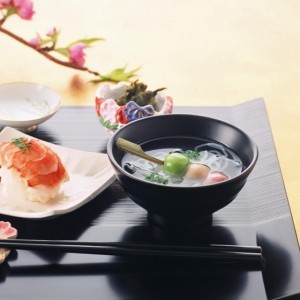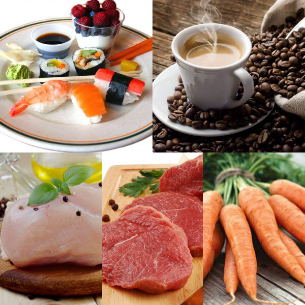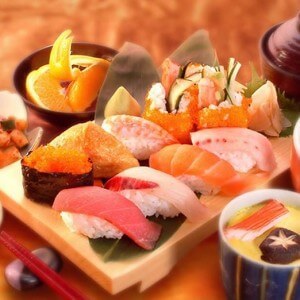
The Japanese-style Diet is a low-carb and low-calorie diet developed by Japanese nutritionists, the protein menu allows you to lose about 10 kg in 2 weeks.
Being overweight today many people call the price of a lifestyle too fast. We are in a hurry to live, in a hurry to work, to hurry to eat and drink. . . Furthermore, we often eat to run and with what, as they say, God will be wrong. And in the 21st century, God increasingly sends us burgers, hot dogs, burgers, and soft drinks. . . "What? Don't waste precious minutes at a restaurant lunch? ! - cook by yourself in the kitchen when your business is running out of stock? Here, they say, entire successful world lives like this and nothing. "This reason is used by a part of people with an active lifestyle. And when your favorite jeans don't fit, when you have to buy a longer belt, when in the middle of a glamorous dress hugs. Tightly on the waist and an ugly look with an elastic band, then we choose the latter option, of course, it's time to come up with a new reason. In fact, all of this, of course, Not the result of inadequate nutrition, but simply . . . a thick skeleton. Yes, yes, and nothing to do with it, a thick bone - it is so, very devilishAnd as soon as it started to evolve - everything, couldn't stop it.
Let us now turn our attention to Japan, a land of vast opportunities, the highest level of technological development and an amazing pace of life. It seems if someone doesn't have time to pause for proper meals, it's like Japanese. But, surprisingly, you rarely get to see people who are "tough" among the inhabitants of Japan. . . So what is the secret then?
The fact that Japanese snacks are low in calories, high in protein, with almost no "bad" fats and carbohydrates. And the main principle of the Eastern culinary tradition is moderation. That is why Japanese cuisine is known as one of the healthiest dishes for the body.
Taking into account the peculiarities of the Eastern nutritional tradition, a well-balanced and extremely effective diet known as Japan was created. In fact, there are practically no foods from traditional Japanese cuisine on the diet's menu. But there are many combinations of proteins, fats and carbohydrates, in the exact amounts needed for the body to get everything it needs without stimulating, and "thickening" the bones. There are several dietary options available, but the most popular is the 14-day Japanese salt-free diet. Two weeks of eating a "standard Japanese" diet will help "thicken bones" lose more than 10 kg and easily maintain results for several years.
The Essence of the Japanese Diet
Those who decide to switch to "Japan" will have to be patient and stay away from their usual diet for two weeks. Diet may seem like a daunting challenge to many people, but the effect won't last long. But great results will remain for many years. There is only a two-week regimen of "Japanese women" - and ten kilograms (sometimes even more - it all depends on initial weight), the same.
So what's the main secret? Why is the Japanese one-week diet better than other diets for weight loss? What great way does it help with weight loss even for those who have tried many other diets to no avail?
It's all about carefully selected products for the diet - they are combined in a way to speed up your metabolism as much as possible. Therefore, it is important to strictly follow all instructions, eat only as directed, not "improve" on its other products, even if at first glance they seem completely swappable. for each other. It is also not recommended to swap the dates of the menu.
For many women, when choosing her diet, her level of "hunger" is very important, since not everyone can fight the samurai's will against the lust ofthemselves, especially the old instinct of all living beings - to be hungry. This is why the fact is that the Japanese two-week salt-free diet is not a "hungry" diet. Adhere to that, you won't have to chew a cabbage for weeks and drink low-fat kefir, curse yourself, your excess weight and those who have been on the diet. The Japanese women's menu has a place for interesting and delicious recipes. This diet will especially appeal to those whose breakfast typically only has coffee. And those who love meat and fish won't find it difficult. This is the best diet for them.
The nature of the Japanese diet can be easily explained in just two words - slow and effective.
"Japanese" is a low-calorie fiber diet. Carbohydrates, which are minimized in the daily diet, force you to lose weight faster - when energy is needed, the body begins to process stored fat into joules. But it's important to remember another thing: The Japanese women's diet will not saturate the body with the entire spectrum of vitamins and minerals. So, absolutely do not diet longer than prescribed (no more than 14 days) lest the weight loss process must lie on the hospital bed.
And if you want to feel like a true Japanese, you can try using Japanese sticks instead of traditional European forks and spoons. They will not only convey the wonderful spirit of the Land of the Rising Sun, but also teach slowly and in small parts. By the way, this tip is well known to many dietary advocates. A leisurely meal can fool your body and make you feel full even after very small meals. In fact, this should be taught by the Japanese on abstinence to lose weight.

Japanese types of diet
The widespread popularity of Japanese-style diets among women around the world has led to the emergence of several options for this system for weight loss. In particular, the known diet options:
- A 7-day salt-free Japanese diet;
- for 13 days (the most common diet);
- for 14 days (different from the previous 13-day diet, only one day);
- Japanese women with green tea;
- Naomi Moriyama's Diet.
Advocates of each of these techniques call their favorite version of "real" Japanese women. Furthermore, many mines have been broken during the copyright disputes of the diet. Some claim that Japanese nutritionists invented it, others claim that the system has nothing to do with the East. Whoever is the author of the Japanese diet, the main thing is it works. And its effectiveness is experienced by millions of donuts around the planet.
The Japanese weight loss diet's menu includes foods with minimal calories, carbohydrates and no salt, spices, sugar and sweets as well as any alcohol, Hence the diet is considered strict. This contributes to the rapid breakdown of body fat, as the body falls under stress and is forced to burn its own fat and calories.
The 7-day diet
The Japanese 7-day diet is both a light version of the traditional Japanese diet, but at the same time, the 7-day diet is the basis of the entire diet.

Predicted Results: 3-5 kg left.
Disadvantages: the lifespan of the results is not guaranteed due to the body has not adapted to the new metabolic system.
Day 1
Calorie content of the daily diet: 700 kcal.
Required products:
- black coffee
- ;
- chicken eggs;
- fresh cabbage (Beijing cabbage / white cabbage);
- tomato juice (ideally freshly squeezed);
- low-fat fish.
Breakfast:
- black coffee - it's better to prefer espresso, but it's better to forget sugar.
Lunch:
- boiled eggs (2 pieces available);
- "Japanese" salad - fresh cabbage and a little vegetable oil, no salt required;
- a glass of tomato juice.
Dinner:
- steamed fish - hake, cod, pollock are ideal (serving size not exceeding 200 grams);
- Japanese salad.
Day 2
Calorie content of the daily diet: 1000 kcal.
Required products:
- coffee
- ;
- rusks;
- fish (fatty breeds);
- cabbage;
- vegetable oil;
- beef;
- kefir.
Breakfast:
- coffee
- ;
- sedge - grab a small one, weigh about 30 grams.
Lunch:
- fish, fried or stewed - to diversify and consume more fatty acids, it is better to prefer catfish, salmon, and black halibut. In total, no more than 150 grams;
- "Japanese" salad.
Dinner:
- beef - boiled about 200 grams. Consume without salt;
- kefir - you can skim, but no more than a 200 gram glass.
Day 3
Calorie content of daily diet: 1000 kcal.
Required products:
- coffee
- ;
- Courgette / parsnip;
- the apple;
- chicken eggs;
- veal;
- cabbage; vegetable oil
- .
Breakfast:
- black coffee - don't forget the sugar ban.
Lunch:
- zucchini (large enough) or parsnip tubers (also large) - brown in vegetable oil (do not use flour or flour for frying, salt is also prohibited);
- apples - don't take it far, you should limit your intake to one.
Dinner:
- boiled eggs - 2 pieces;
- boiled veal - limits appetite to 200 gram pieces prepared in a salt-free manner;
- "Japanese" salad.
Day 4
Calorie content of the daily diet: 1000 kcal.
Required products:
- coffee
- ;
- carrots;
- hard cheese;
- chicken eggs;
- apple.
Breakfast:
- unsweetened black coffee.
Lunch:
- carrots - boiled, allowed to take 3 larger bulbs;
- some cheeses - choose from hard ones, limited to 20 grams;
- raw chicken eggs - one is enough.
All ingredients of a 4-day lunch, if desired, can be combined into a single dish - salad.
Dinner:
- apples - certain fruits are allowed.
At this point, the feeling of hunger will not be as strong as before. The feeling of fullness comes after eating small portions.
Day 5
Calorie content of daily diet: 800-1000 kcal.
Required products:
- carrots;
- lemon juice;
- sea fish; Juice
- ;
- fruit.
Breakfast:
- carrot and lemon juice - grated vegetables and seasoned with juice. You cannot add sugar. Also excluded on this day from breakfast and coffee.
Lunch:
- fried fish - 350-400 grams, a variety - any sea;
- tomato juice - for the diet, it is more correct to use fresh, homemade juices. Weight - no more than 200 grams.
Dinner:
- fruit - but should not be consumed under all circumstances, especially at bedtime, grapes or bananas. They will cross out all results so far.
Day 6
Calorie content of daily diet: 900-1100 kcal.
Required products:
- coffee
- ;
- chicken fillets;
- raw cabbage;
- carrots;
- vegetable oil;
- chicken eggs.
Breakfast:
- unsweetened black coffee.
Lunch:
- chicken fillet - dietary limit of 500 g, skinless meat. Boil in water without adding salt;
- salad - on this day the traditional "Japanese" salad can be improved by adding grated raw carrots.
Dinner:
- chicken eggs - boiled 2 pieces;
- carrot (you can get large) - scrape raw vegetables, season your salad with some vegetable oil (maybe olive oil).
Day 7
Calorie content of the daily diet: 700-800 kcal.
Required products:
- tea
- ;
- fruit; beef
- ;
- eggs;
- cabbage; vegetable oil
- .
Breakfast:
- Tea
- - should choose good green teas, rich in beneficial antioxidants.
Lunch:
- Beef
- - boiled about 200 grams. Do not use salt or other spices while cooking;
- fruit - on the last day of the diet you can reward yourself with a dessert at lunch. But don't forget about the ban on the use of bananas and grapes.
Dinner:
On this day for dinner, as a reward for endurance, you can choose any of the dining options from the previous days. For example, choose a salad of beef, eggs, and cabbage with olive oil.
This will end the diet for some people. For those who have opted for longer versions of Japanese women, Saturday is just the equator of self-change work.
For those who are not used to eating by counting calories, "Japan" may seem a rather difficult choice to lose weight at first. But discomfort will only become noticeable in the first few days - then the body adapts to small portions of food, and starts eating faster. After 5 days of implementing a new diet in the body begins the first restructuring phase is to increase the metabolic rate - the main goal of any diet is to lose excess weight, excess fluidseliminated, the edema disappeared. To get the best results in parallel with your diet, you can do an anti-cellulite massage.
13-day Japanese diet
The Japanese 13-day diet is the most popular. This version is considered a complete weight loss routine.
Predicted results. If you are ashamed to follow all the prescriptions, by the end of day 13, you will be short of around 10 kg and about 30 cm (sometimes more).
How does it differ from the 7-day option? In fact, this is a sequel to the light version of "Japanese slapstick". That means you will have to spend 7 days living "Japan", to the 8th day then starting over from the beginning to the Friday.

14-day Japanese diet
The basis for the 14-day version of the Japanese diet is also the 7-day menu, albeit with some nuances. The main difference from the previous two plans is that the first week you need to strictly follow the 7-day menu, the second week should follow the same program, but in reverse order. This means that the diet of the eighth day corresponds to the diet of the last day of the seventh day, of the ninth day - the menu of the sixth day, the tenth day - the menu of the fifth day . . . andFollowing this principle, continue until the end of the second. weekly. According to this, the first 14 months of the result was made to be the first of the 7-year "Japanese woman".
Starting from day 8 of the diet, detoxification is activated in the body, and due to the principle of salt-free nutrition, excess fluids at the intercellular level are eliminated and eliminated. completely edema. It is important that at the second week of the diet, the body is accustomed to the new metabolic rate. This way, even after switching to a regular (normal - this doesn't mean you have to eat again in the tub for the next sleep, but you don't have to live on a “hungry” diet. ), the body will not gain weight, on the contrary - fat will be burned as quickly as during the diet. This amazing effect will last for about 2 years. But provided that the correct diet is maintained. Those who have gone through the work of a "Japanese woman" claim that one year after completing the diet, their weight will continue to be reduced. If you repeat "Japanese women" again (but no earlier than six months after the first session), then in a year, practically without effort, can actually get rid of 20 kg of weightredundancy.
Diet and salt
Have you ever wondered why almost every more or less diet has a salt diet? The point is, according to experts,
1 gram of salt retains a liter of fluid in the body.
And this is just the weight in excess of one kilogram. In addition to the erroneous excess weight, because thanks to salt, weight is accumulated not by fat layer, but by liquid stagnation, consuming too much salinity causing other problems for humans. Even a few days of salt-free meals can lower blood cholesterol levels and improve the condition of blood vessels.
Of course, salt cannot be completely removed from consumption, and that cannot be done. But the menu of "Japanese ladies" has products already containing a certain amount of salt - enough for the normal functioning of the agencies. Especially organic rice in some vegetables, fish, meat. You cannot eat canned vegetables, bacon, and semi-finished products in the diet - they all have a sizable amount of table salt in their composition.
Green tea
In addition to the classic version of the Japanese diet, there is also an option on the menu where instead of coffee you should go for green tea. Many nutrition experts evaluate how this variation of "Japanese women" is more beneficial for the body.
Considering that the Japanese diet is based on a protein diet, it is important that green tea (specifically the Japanese form) contains a huge amount of protein, and in terms of nutritional value, this drinknot inferior to beans.
The second plus of green tea is the presence in the composition of antioxidants that help protect the body from toxins and promote toxin excretion.
Third, and probably the most important thing for weight loss, green tea's unique chemical composition increases the metabolic rate by 4% (60 calories are burned daily more thando not use green tea).
The Japanese green tea diet lasts 2 weeks. The actual ingredients are the same as in the classic version of "Japanese", though still have some great features.

Detailed Japanese-style green tea diet menu
Day 1 / Day 14
Breakfast:
- green tea - cup;
- nonfat fresh cheese - 150 g.
Lunch:
- cabbage, stew with butter - 300 g;
- boiled chicken eggs - 2 pcs. ;
- fresh apples - cups.
Dinner:
- vegetables in salad or steamed;
- boiled or steamed fish - 200 g.
Day 2 / Day 13
Breakfast:
- green tea - cup;
- hard cheese - 2 pieces;
- toast or diet crackers.
Lunch:
- boiled or raw cabbage, oiled;
- boiled fish;
- green tea - cup.
Dinner:
- vegetable salad;
- boiled veal - 300 g;
- boiled chicken eggs - 2 pcs;
- Japanese green tea - cup.
Day 3 / Day 12
Breakfast:
- Japanese green tea - cup;
- diet cookies.
Lunch:
- boiled zucchini / cauliflower;
- apples - 1 pc. ;
- green tea - cup.
Dinner:
- yellow green vegetable salad;
- boiled veal;
- boiled chicken eggs - 2 pcs.
4 / Day 11
Breakfast:
- Japanese green tea - cup;
- nonfat fresh cheese - 150 g.
Lunch:
- raw grated carrots with olive oil;
- chicken eggs;
- unsweetened green tea.
Dinner:
- green tea
- ;
- fruit (not grapes and bananas).
5th / Day 10
Breakfast:
- green tea - cup;
- toast with jam - 2 pcs.
Lunch:
- boiled fish - 200 g;
- tomato juice - cup.
Dinner:
- green vegetable salad;
- hard cheese - 2 pieces;
- green tea - cup.
6 / Day 9
Breakfast:
- rye toast - 2 pcs. ;
- Japanese green tea - cup.
Lunch:
- raw / boiled cabbage with olive oil;
- skinless boiled chicken - 400 g;
- Japanese tea - cup.
Dinner:
- carrots (boiled / raw);
- boiled eggs - 2 pcs. ;
- unsweetened green tea.
7 / Day 8
Breakfast:
- Japanese tea - cup; Cheese
- (any hard type) - 2 small pieces.
Lunch:
- boiled veal - 200 g;
- boiled / steamed vegetables;
- unsweetened green tea - cup.
Dinner:
- fruit - any;
- Japanese green tea - cup.
The effectiveness of this variation of the Japanese diet is enhanced by the addition of green tea to the diet, and the variety and palatability of the menu make it easier to endure deadlines. food preparation. Repeat the diet - no earlier than a year later. And so, in two weeks, the results are maintained for longer, in the future should adhere to a healthy lifestyle, eliminate smoking, limit alcohol consumption and follow proper nutrition in daily life. .

Main Course
No matter which Japanese diet you choose, which of them will feature a traditional cabbage salad and boiled meat. These dishes can be prepared in many different ways. But keep in mind that they are part of the diet and the cooking process is slightly different from cooking. normal meal.
How To Make A Perfect Japanese Salad:
- Take raw or lightly cooked cabbage (regular or Beijing cabbage).
- Cut fine.
- Easily removes excess moisture.
- Add olive or sesame oil to a prepared salad.
- Stir well and let it incubate.
Boiled meat diet
- Prepare the meat. If it's chicken, remove the skin. Peel the veal or beef off the membrane.
- Rinse thoroughly with cold water.
- Put the meat in the pan, rinse with very cold water.
- After boiling, drain, rinse the meat and fill with water again, light.
- Cook until tender without adding seasoning.
Tip: add an onion, a small carrot and a little green plants to the water to improve the taste while cooking. Many people wonder how to replace beef in the Japanese diet. Young veal can be included in the menu for easier digestion, but it must have the same chemical composition as beef.
How are the products selected?
Almost all sources say that the list of allowed foods in the Japanese diet is special and should not be changed. So what's the secret to this particular diet?

Coffee. Many people start their day with this scented drink. A cup of black coffee is used as a traditional breakfast and in the Japanese diet.
What are the uses?
Unsweetened black coffee has an invigorating effect, helps the body stay awake faster and starts the process of burning calories. And since food intake is not provided by the diet in the morning, the body begins to produce energy by burning its own reserves - subcutaneous fat.
You can diversify the flavor of a morning drink by adding vanilla, dark chocolate or citrus fruit. Add additional ingredients in small doses.
Cabbage. This vegetable was not chosen by chance. In addition, cabbage is one of those vegetables with a caloric content known as "minus" (the body spends more energy digesting than it receives).
What are the uses?
Cabbage, white cabbage or Beijing cabbage, has the effect of strengthening blood vessel walls, lowering cholesterol levels and cleaning the intestines. For those prone to bloating, it is better to boil the cabbage a little before serving.
Olive oil. One teaspoon of oil added to the salad will normalize metabolism, having a beneficial effect on the liver, kidneys and pancreas.
Eggs. This product has good nutritional properties and is an excellent source of protein, fats and carbohydrates, as well as a wide variety of vitamins and minerals.
Tomato juice. Nutritionists call it one of the healthiest foods. The unique chemical composition of tomatoes prevents cardiovascular diseases and cancer, speeds up metabolism in the body, improves mood and has a beneficial effect on the nervous system. It is best absorbed without adding salt, which is especially important on a salt-free diet.
Fish. Known for its ability to remove toxins and poisons quickly. It is a valuable source of protein and amino acids. It affects the body as a preventive measure against stroke.
Fruit. Normally, during dieting, the amount of carbohydrate consumed should be drastically reduced. But absolutely undesirable exclusion from the diet - they are an important source of energy. The body receives the "correct" carbohydrates along with the fruit. But from the diet it is better to exclude bananas and grapes, which contain a lot of sugar.

Naomi Moriyama's Diet
It's hard not to believe the effectiveness of the Japanese-style diet, especially for those who have decided to try it on their own. But sooner or later, many people wonder: why is this so called "the Japanese diet" if there is practically nothing on the menu? from the traditional dishes of the country of the rising sun. But there is an explanation for this. According to one of the versions, this original diet was a development by nutritionists from the Japanese clinic "Yaelo".
But there is another version of "Japanese", created by marketer Naomi Moriyama - as an answer to French woman Mireille Guiliano, author of the book "Why French Women Are Not Fat". In fact, according to research, the French are not the thinnest in the world. The least obese people live in Japan - just 3%, while in France there are about 11% donuts and in America - more than 32%. Thus, Naomi gathered the nutritional principles that were characteristic of her person and adapted them into a diet.
Eating and drinking rules from the Land of the Rising Sun
Eastern residents eat almost 100 different foods each week, the total calories of which are a quarter less than the American weekly calorie intake. And the only secret about Japanese harmony lies in one simple rule: 80 percent fill the stomach.














































































